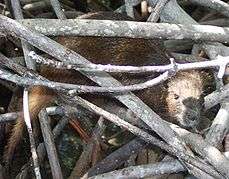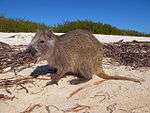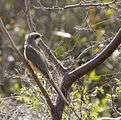Greater Antilles mangroves
Because Cuba is an archipelago made up by 4197 islands,[1] two of them being the largest ones; Cuba proper and Isla de la Juventud, the combined area of coast results in 5,746 square kilometers (3570.4 square miles) most of it – 2,200 square miles - covered by Mangrove forest.[2] These Mangrove forests make up 20 percent of the forested areas in the island, covering a total of 4.8 percent of the territory.[3]
_(5179965426)_(2).jpg) American flamingos (Phoenicopterus ruber) feeding in a saltwater lagoon surrounded by a mangrove forest in Cuba. | |
| Ecology | |
|---|---|
| Realm | Neotropical |
| Biome | mangroves |
| Geography | |
| Area | 3,540.56 km2 (1,367.02 sq mi) |
| Countries | |
| Conservation | |
| Conservation status | Critical/endangered |
Flora
Cuban Mangrove forests top layer is made up by 4 tree species; Rhizophora mangle (Red mangrove), Avicennia germinans (Black mangrove), Laguncularia racemosa (White mangrove) and Conocarpus erectus (Button mangrove). Depending on several factors, including water salinity, fresh water flow, coast shape and how deep it is affects the size of those 4 predominant species and how much they mix. In some places we can speak of a mono-forest (made up by just one species) in some other places all 4 species occur naturally. Sizes vary from very tall forests with a canopy at 15 meters (49.21 feet) of altitude, or they can look as small as shrubs no taller than 2 meters (6.56 feet).[4]
The Mangrove forest is also built with many other botanical species; they are usually identified as “associated species”. This a short list of the most predominant; Thespesia populnea (Portia tree), Hibiscus tiliaceus (Sea hibiscus), Bontia daphnoides (Sea olive), Haematoxylum campechianum (Bloodwood), Bravaisia tubiflora (Hulube), Dalbergia ecastophyllum (Dalbergia) and several species of trees from the Lucida genera. Salinity permitting, in some areas the forest is also formed by under story species adapted to high levels of salt; Acrostichum aureum (golden leather fern), Batis marítima (Saltwort)
And among the branches of the larger trees live a large amount of epiphyt plants of the Tillandsia genera -usually called by their Taino name Curujeyes in Cuba and the rest of the Caribbean islands and referred as Bromeliads in English-. Many types of orchids from the Encyclea, Tulumnea and Vanilla genera.
Fauna

What makes a Mangrove ecosystem incredibly rich however is the animal species that live on it. Mangroves are well known spots for many migratory and endemic species of birds. Many fish, sponges, crustaceans and mollusks. Cuban mangroves are also the home of choice of the Cuban crocodile Crocodylus rhombifer, Cuban Rock Iguana cyclura nubila and the Cuban hutias Capromys family.
A complete list of all botanical and animal species associated with a Cuban Mangrove forest is described in the paper “Ecosistemas de Manglar en el Archipiélago Cubano. By Leda Menéndez Carrera and José M. Guzmán Menéndez) edited and distributed by the Cuban Science Academy and UNESCO.
Economy
Historically speaking, mangroves were a key factor in the development of the aboriginal cultures that populated Cuba before the arrival of the Spanish conquistadors. Aboriginal communities established first on maritime coast around mangrove areas where the sea and rivers meet. For centuries those types of locations would provide them with a rich source of sustenance.[4]
Later on, during colonial and Republican times, mangroves were put to commercial use. Over 400 years of heavy harvesting put a pressure on the ecosystem. Either used as textile dyes, tannin for pharmaceutical industries, lumber for furniture, charcoal, even as a popular wine flavoring.[5][6]
Conservation
A special blow to the well being of the Mangrove forests was executed in the 60’s when the current came to power. At the moment the Cuban authorities realized the supply of fresh water for the increasing Cuban population had to be solved one way or another. As a tropical nation, Cuba has only two seasons; rain and dry. Over the rainy season the island is constantly battered by hurricanes as opposed to the 5 to 6 months of dry season lasts bringing heavy drought. In order to solve those issues over 969 reservoirs were created therefore reducing the fresh water flow that keeps mangroves healthy on the coast line.
The reservoir construction policy has claimed half a century later an unforeseen victim; mangroves. In some places of the island, such as in Batabanó these ecosystems have been critically severed and as a result hundreds of kilometers of coast that were arable or populated have been claim by rising sea levels, especially during storm season, proving that what was believed to be a solution, has become instead a huge problem.[3]
The Cuban government has not kept idle though. If there is something positive to say about Cuban Conservation Laws is that they quickly enforced in order to correct the issues that Mangroves and other inland ecosystems have suffered. In 2013 Environmental authorities started a program in order to defend and recover they first line of defense against advancing waters and effects of salinization of farmlands; fixing their Mangrove forests.
A moratorium on mangrove foresting was declared and ways to reforest and restore fresh water intake have been designed and should soon be in place, if they are not already been.[5]
For whatever reason, even with the negative impacts of 500 years of irresponsible actions, Cuban Mangroves are still the most conserved in the Caribbean basin, making up for a 69 percent of this region coastal forests, they are also the most well preserved. Even if areas around former province of Havana, now the provinces of Artemisa and Mayabeque are critical, in other spaces like Ciénaga de Zapata, Jardines de la Reina and Jardines del Rey, the mangrove coverage has discretely improved.
Gallery
- A lagoon surrounded by a Mangrove forest used by a fishing community in Caibarién, Villa Clara Province, Cuba
- Mangrove forest in a dry lagoon near Casilda Port, Sancti Spiritus Province, Cuba
- Mangrove forest along Hatiguanico river in the Zapata Swamp, province of Matanzas.
.jpg) Mangrove tree in Cayo Jutías, Pinar del Río Province, Cuba.
Mangrove tree in Cayo Jutías, Pinar del Río Province, Cuba. Cuban Jutia (pronounce Hooteeah) in its natural habitat.
Cuban Jutia (pronounce Hooteeah) in its natural habitat.- Cuban crocodile in Zapata.
 A Mangrove Cuckoo in Cuba.
A Mangrove Cuckoo in Cuba._(8596821399).jpg) Cuban parrot
Cuban parrot
References
- es:Geografía de Cuba
- "Cuba". World Wildlife Fund.
- "Cuba's Mangroves Dying of Thirst". ipsnews.net.
- http://www.unesco.org.uy/ci/fileadmin/ciencias%20naturales/mab/EcosistemasManglarCuba.pdf
- "Cuba looks to mangroves to fend off rising seas - CTV News". CTVNews.
- "Vino de Miel y Mangle Rojo". ratebeer.com.